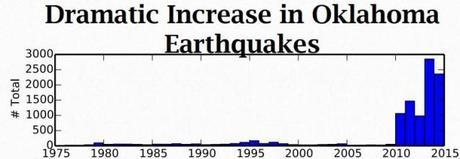by Emily Atkin / Climate Progress
Oklahoma’s Geology Survey recorded an unprecedented 20 small earthquakes across the state on Tuesday, highlighting the dramatic increase of seismic activity that has occurred there as the controversial process of hydraulic fracturing — otherwise known as fracking — has spread across the state.
Though 18 out of the 20 earthquakes that occurred Tuesday were below Magnitude 3, rendering them mostly imperceptible, the largest one registered as a 4.3 near Guthrie, a city of more than 10,000 residents. And while U.S. Geological Survey scientists have said that Oklahoma is historically known as “earthquake country,” they also warn that quakes have been steadily on the rise; from 1978 until 2008, the average rate of earthquakes registering a magnitude of 3.0 or more was only two per year.
“No documented cases of induced seismicity have ever come close to the current earthquake rates or the area over which the earthquakes are occurring,” the Oklahoma Geology Survey said in a recent presentation addressing the alarming increase in quakes. By “induced seismicity,” the OGS is referring to minor earthquakes that are caused by human activity, whether that be fracking, mass removal mining, reservoir impoundment, or geothermal production — anything that could disrupt existing fault lines.
One of the most researched human activities that could be causing the dramatic increase in earthquakes is fracking. The process that could be causing the quakes is not the fuel extraction itself, but a process called “wastewater injection,” in which companies take the leftover water used to frack natural gas wells and inject it deep into the ground. Scientists increasingly believe that the large amount of water that is injected into the ground after a well is fracked can change the state of stress on existing fault lines to the point of failure, causing earthquakes.
Cornell University geophysics professor Katie Keranen is the latest researcher to produce a scientific study showing a probable connection between earthquakes wastewater injection, finding in July that the more than 2,500 small earthquakes that have hit Oklahoma in the past five years can be linked to it. Keranen’s study analyzed four prolific wastewater disposal wells in southeast Oklahoma City, which collectively inject approximately four million barrels of wastewater into the ground each month. The research showed that fluid from those wells was migrating along fault lines for miles, and Keranen’s team determined the migration was likely responsible for earthquakes occurring as far as 22 miles away.
The link between earthquakes and wastewater injection from fracking is not definitive. As Jennifer Dlouhy in Fuel Fix notes, the research lacks necessary data on sub-surface pressure, which is rarely accessible.
The OGS says that as it is now, the chances of a large, damaging earthquake happening in Oklahoma are small. However, some scientists have warned that seismic activity stands to get stronger and more dangerous as fracking increases.
“I think ultimately, as fluids propagate and cover a larger space, the likelihood that it could find a larger fault and generate larger seismic events goes up,” Western University earth sciences professor Gail Atkinson said at a Seismological Society of America conference in May.
As of publication Wednesday, five more earthquakes had already occurred in Oklahoma, three of which registered on or above the 3.0 magnitude mark.

